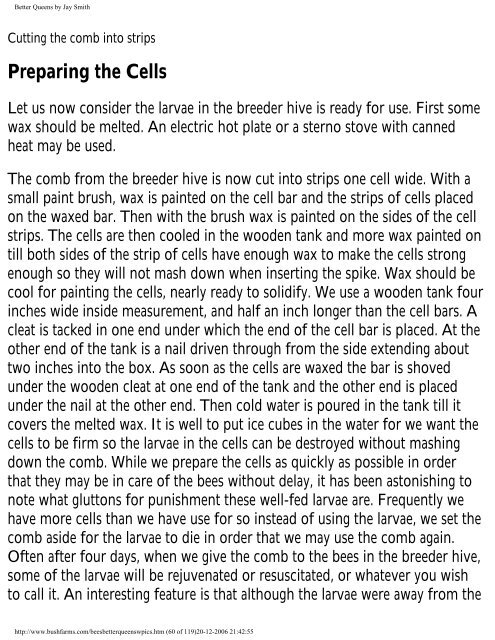Create successful ePaper yourself
Turn your PDF publications into a flip-book with our unique Google optimized e-Paper software.
<strong>Better</strong> <strong>Queens</strong> <strong>by</strong> <strong>Jay</strong> <strong>Smith</strong><br />
Cutting the comb into strips<br />
Preparing the Cells<br />
Let us now consider the larvae in the breeder hive is ready for use. First some<br />
wax should be melted. An electric hot plate or a sterno stove with canned<br />
heat may be used.<br />
The comb from the breeder hive is now cut into strips one cell wide. With a<br />
small paint brush, wax is painted on the cell bar and the strips of cells placed<br />
on the waxed bar. Then with the brush wax is painted on the sides of the cell<br />
strips. The cells are then cooled in the wooden tank and more wax painted on<br />
till both sides of the strip of cells have enough wax to make the cells strong<br />
enough so they will not mash down when inserting the spike. Wax should be<br />
cool for painting the cells, nearly ready to solidify. We use a wooden tank four<br />
inches wide inside measurement, and half an inch longer than the cell bars. A<br />
cleat is tacked in one end under which the end of the cell bar is placed. At the<br />
other end of the tank is a nail driven through from the side extending about<br />
two inches into the box. As soon as the cells are waxed the bar is shoved<br />
under the wooden cleat at one end of the tank and the other end is placed<br />
under the nail at the other end. Then cold water is poured in the tank till it<br />
covers the melted wax. It is well to put ice cubes in the water for we want the<br />
cells to be firm so the larvae in the cells can be destroyed without mashing<br />
down the comb. While we prepare the cells as quickly as possible in order<br />
that they may be in care of the bees without delay, it has been astonishing to<br />
note what gluttons for punishment these well-fed larvae are. Frequently we<br />
have more cells than we have use for so instead of using the larvae, we set the<br />
comb aside for the larvae to die in order that we may use the comb again.<br />
Often after four days, when we give the comb to the bees in the breeder hive,<br />
some of the larvae will be rejuvenated or resuscitated, or whatever you wish<br />
to call it. An interesting feature is that although the larvae were away from the<br />
http://www.bushfarms.com/beesbetterqueenswpics.htm (60 of 119)20-12-2006 21:42:55


